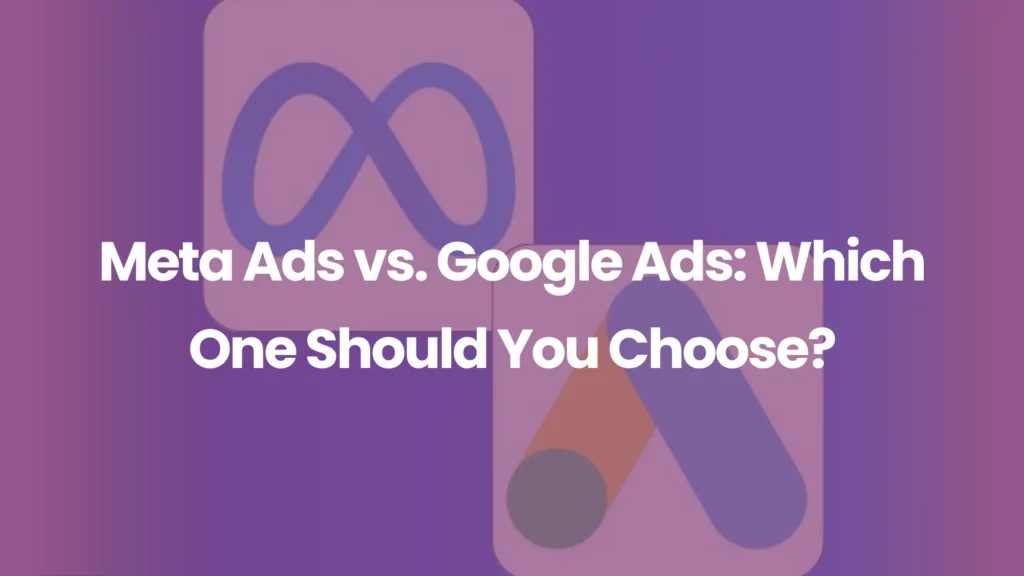
When businesses or marketers think of running online ads, two platforms usually come to mind: Meta Ads (formerly Facebook Ads) and Google Ads. Both are giants in the world of digital advertising, offering powerful tools to reach highly targeted audiences and drive results. However, choosing between them can be confusing, especially if you’re just getting started.
So how do you know which one is right for your business? The answer depends on your goals, audience, budget, and marketing strategy.
In this blog post, we will explore the key differences, benefits, limitations, and best use cases for both Meta Ads and Google Ads, helping you decide which platform to invest in.
What Are Meta Ads?
Meta Ads refer to advertising across Meta-owned platforms, including:
- Messenger
- Audience Network (partner sites and apps)
Meta Ads are display ads that appear in social feeds, stories, reels, and sidebar placements. These ads are primarily interruption-based, meaning users are shown ads while scrolling through social content, not while actively searching for something.
Advantages of Meta Ads:
- Highly Detailed Targeting
Meta allows targeting based on interests, behaviors, demographics, life events, job titles, and more. You can create lookalike audiences or retarget website visitors. - Strong Visual Impact
Meta’s ad formats include image, video, carousel, and collection ads, which are great for storytelling and brand engagement. - Great for Brand Awareness and Engagement
These ads are effective when your goal is to build brand presence, drive likes/follows, or generate leads through engaging content. - Instagram Integration
With over a billion active users, Instagram (owned by Meta) offers great exposure, especially for visual-first brands.
What Are Google Ads?
Google Ads is Google’s online advertising platform that allows businesses to place ads on:
- Google Search
- YouTube
- Gmail
- Google Display Network (millions of partner websites and apps)
Google Ads is based on intent-based advertising, meaning ads are shown to users actively searching for a product, service, or answer.
Advantages of Google Ads:
- High Purchase Intent
When someone types “buy running shoes online” into Google, they are already close to making a purchase. Google Ads helps you appear at that exact moment. - Search and Display Options
Google offers both search ads (text-based) and display/video ads (visual), giving you multiple ways to reach your audience. - Massive Reach
Google processes over 8.5 billion searches a day. With proper targeting, your ads can reach almost any audience globally. - Powerful Analytics and Control
Google Ads offers robust tools to measure conversions, tweak bids, test creatives, and optimize for specific goals.
Meta Ads vs. Google Ads – Key Differences
| Feature | Meta Ads | Google Ads |
|---|---|---|
| Platform Type | Social Media | Search Engine + Display |
| User Intent | Low (passive browsing) | High (active search) |
| Ad Formats | Image, video, carousel, stories | Text, image, video, shopping |
| Targeting | Behavior and interest-based | Keyword and intent-based |
| Best For | Brand awareness, lead gen, engagement | Direct response, high-intent sales, local search |
| Cost (CPC) | Often lower | Can be higher (depending on keyword competition) |
| Analytics | Easy-to-use dashboard | Advanced, granular tracking |
When to Choose Meta Ads
Meta Ads are ideal if:
- You’re targeting top-of-funnel audiences who haven’t heard of you yet
- Your product/service is visual or appeals emotionally (e.g., fashion, beauty, lifestyle)
- You want to grow your social following or generate leads through forms
- Your target audience is highly active on Facebook and Instagram
- You have a tight budget and want to test visuals or creative storytelling
Example Use Cases:
- Promoting an online fashion brand through Instagram Reels
- Running a lead generation campaign for a coaching business
- Driving traffic to a new blog, YouTube channel, or product launch
When to Choose Google Ads
Google Ads are best if:
- Your audience is already searching for your product/service
- You want immediate traffic and conversions
- You’re promoting something people actively seek (e.g., services like “plumber near me” or “buy laptop online”)
- Your goal is ROI-focused performance advertising
- You’re selling on e-commerce platforms or offering local services
Example Use Cases:
- A local salon running search ads for “best salon in Delhi”
- An e-commerce site running shopping ads for mobile phones
- A travel company advertising flights or hotel bookings
Budget Considerations
- Meta Ads often have lower CPCs (Cost-Per-Click), especially for brand awareness or engagement campaigns. You can get high reach with a limited budget.
- Google Ads may be more expensive, especially for competitive keywords like “insurance” or “lawyer.” However, the conversion rate can be higher due to strong user intent.
Always test your campaigns on a small scale, measure performance, and then scale up what works.
Combining Meta Ads and Google Ads
You don’t have to choose one over the other. Many successful businesses use both platforms together for full-funnel marketing.
Example Strategy:
- Use Meta Ads to attract attention and build awareness with engaging video or carousel ads.
- Use Google Search Ads to convert high-intent users who search for your product or brand after seeing your ad on social media.
- Use Meta Retargeting Ads to bring back people who visited your website but didn’t convert.
Combining both platforms ensures you’re reaching people at different stages of their customer journey—from awareness to decision.
Final Thoughts
So, which one should you choose—Meta Ads or Google Ads?
The answer is: it depends on your business goals and audience behavior.
If you’re focused on awareness, engagement, or visual storytelling, Meta Ads are your best bet. If you’re looking for high-intent conversions and measurable ROI, Google Ads might be more effective.
As a digital marketer, understanding both platforms allows you to build well-rounded campaigns that work across channels. The real power comes when you know how and when to use each platform strategically.
If you’re still unsure or want help setting up your Meta or Google Ads, feel free to reach out. I help businesses craft campaigns that convert and grow with confidence.
Written by: Isha Sharma
Digital Marketer | Paid Ads Specialist | Blogger
